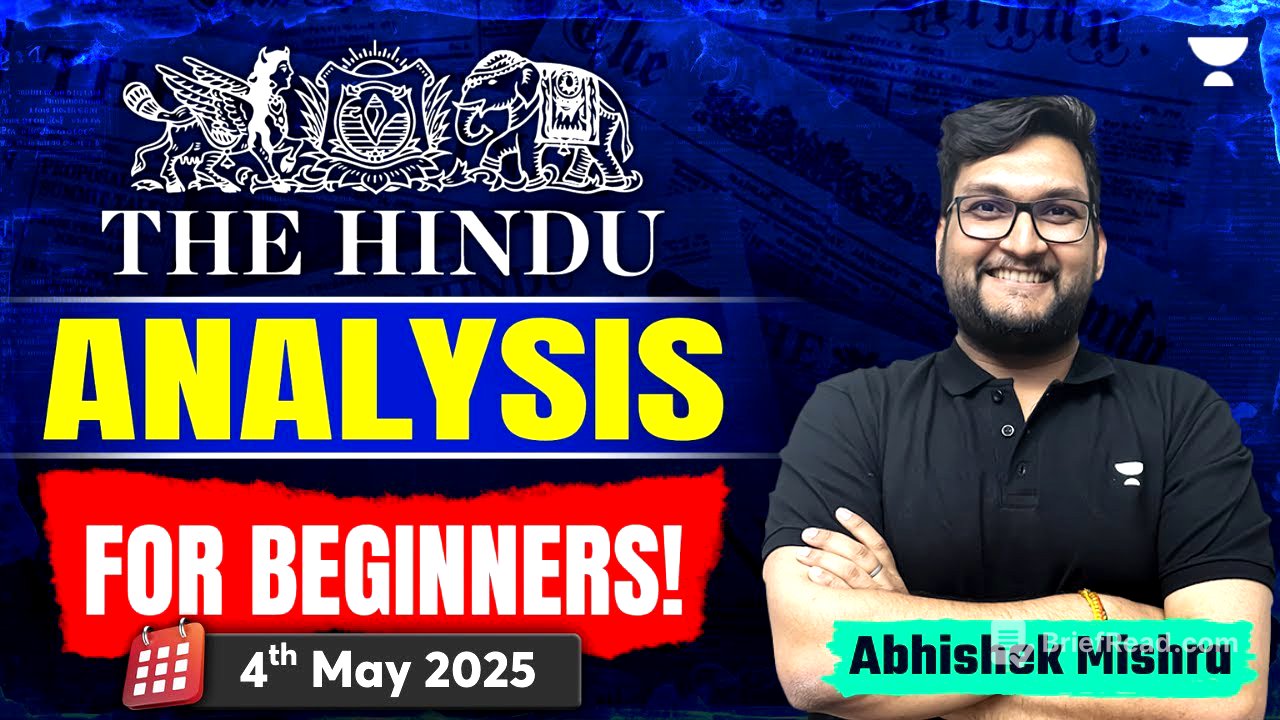TLDR;
This session covers six important articles from The Hindu newspaper, focusing on caste census, rising vaccine-preventable diseases, public R&D innovation, India-Pakistan relations, judicial vacancies and backlogs, and the impact of Rafale aircraft on the Indian Navy. Key takeaways include understanding the complexities of caste in India, the alarming trend of declining immunisation rates globally, the need for more curiosity-driven research in India, the dire state of judicial vacancies and pending cases, and the enhancement of naval capabilities with the induction of Rafale aircraft.
- Caste is a complex concept with historical roots and modern implications for census and policy.
- Vaccine-preventable diseases are rising due to misinformation, conflict, and funding shortages.
- Public R&D in India needs more focus on curiosity-driven research and critical technologies.
- Judicial vacancies and backlogs are a major crisis, hindering access to justice.
- Rafale aircraft will enhance the Indian Navy's fighter strength.
Introduction [0:00]
The session begins with a welcome and an overview of the six articles to be discussed from The Hindu newspaper. The presenter highlights the importance of the FAQ section in the Delhi edition and reminds viewers about an offer ending soon for Unacademy IAS subscriptions. The PPT for the session will be available on the provided Telegram channel. The articles cover caste census, vaccination trends, research and development, India-Pakistan relations, judicial vacancies, and the Rafale aircraft.
What are the key objectives of caste count? [3:38]
This section addresses the complexities surrounding caste census in India. The presenter begins by differentiating between "varna," "caste," and "jati," explaining their historical context and how the British colonial influence distorted these terms. Before the 15th century, "varna" and "jati" were the primary terms, but the Portuguese introduced "castas," which became "caste." The British further complicated the concept by associating "jati" with tribes and "caste" with social differentiation. Jati formation occurred through assimilation of foreigners and intermixing of varnas, leading to subcategorisation within varna identities. The British census, particularly in 1881 and 1901, created numerous subcategories, making it difficult to accurately ascertain caste today. The presenter highlights the challenges of integrating caste into the census due to the vast number of castes and subcastes, and the potential for misuse in vote bank politics.
Are vaccine-preventable diseases rising? [50:17]
This part discusses the alarming trend of rising vaccine-preventable diseases globally. While vaccines have saved millions of lives, factors such as funding cuts, geopolitical tensions, conflict, and misinformation are causing immunisation rates to decline. Organisations like WHO, UNICEF, and Gavi have pointed out that humanitarian crises and refugee situations prioritise basic needs over vaccines. Misinformation, fuelled by figures like Donald Trump, is also contributing to vaccine hesitancy. Data shows a significant increase in children missing routine vaccinations, leading to measles outbreaks in developed countries like the US. The presenter stresses the need to strengthen support for immunisation to prevent a regression in public health.
Do public R&D units innovate enough? [1:05:04]
This section examines whether public research and development (R&D) units in India are innovating sufficiently. The study excludes defence, atomic research, and space sectors. The presenter emphasises the importance of valuing researchers and scientists for national progress. There are two types of research: curiosity-driven academic research and industry-demand-based research. Curiosity-driven research is crucial for true innovation. A survey of 244 R&D organisations reveals that many are focused on demand-driven initiatives like Make in India and Swachh Bharat Mission. A concerning trend is the increasing number of contractual employees and the stagnation of women in research. The presenter argues that India needs to reorient its R&D focus towards critical technologies and long-term growth.
India cuts trade, postal, port links with Pakistan [1:16:24]
India has severed critical ties with Pakistan, including postal, trade, and port links. This action includes suspending postal services, prohibiting direct and indirect trade, and banning Pakistani-flagged ships from docking in Indian ports. This move is seen as a response to Pakistan's test-firing of nuclear-capable missiles and military exercises near the Line of Control (LOC). The presenter notes that India is gradually closing diplomatic channels, following actions such as putting the Indus Waters Treaty (IWT) into abeyance and tightening visa controls.
Chronic judicial vacancies, backlog of cases plague various High Courts [1:18:32]
This part addresses the critical issue of judicial vacancies and the backlog of cases in Indian courts. The data reveals shocking statistics: Delhi High Court has 40% of its judicial posts vacant, and Allahabad High Court has nearly half of its seats unoccupied. Overall, 30% of all positions in India's 25 high courts are vacant. This has led to a massive pendency of cases, with 81,000 cases pending in the Supreme Court, 62 lakh in high courts, and 4.57 crore in subordinate courts. The presenter criticises the judicial culture, including the concept of vacation benches, and calls for judicial reform from within to address the crisis.
With 26 Rafales, aircraft carriers will have a full fighter strength [1:30:36]
By 2028-2030, India will receive 26 Rafale aircraft from France, enhancing the fighter strength of its aircraft carriers, INS Vikramaditya and INS Vikrant. This induction will allow India to retire its MiG-29Ks and Sukhoi MKIK aircraft configured for the Navy. While the Rafale is a 4.5-generation fighter, it will require some retrofitting of the aircraft carriers. The presenter concludes by summarising the key points from all the articles discussed.









